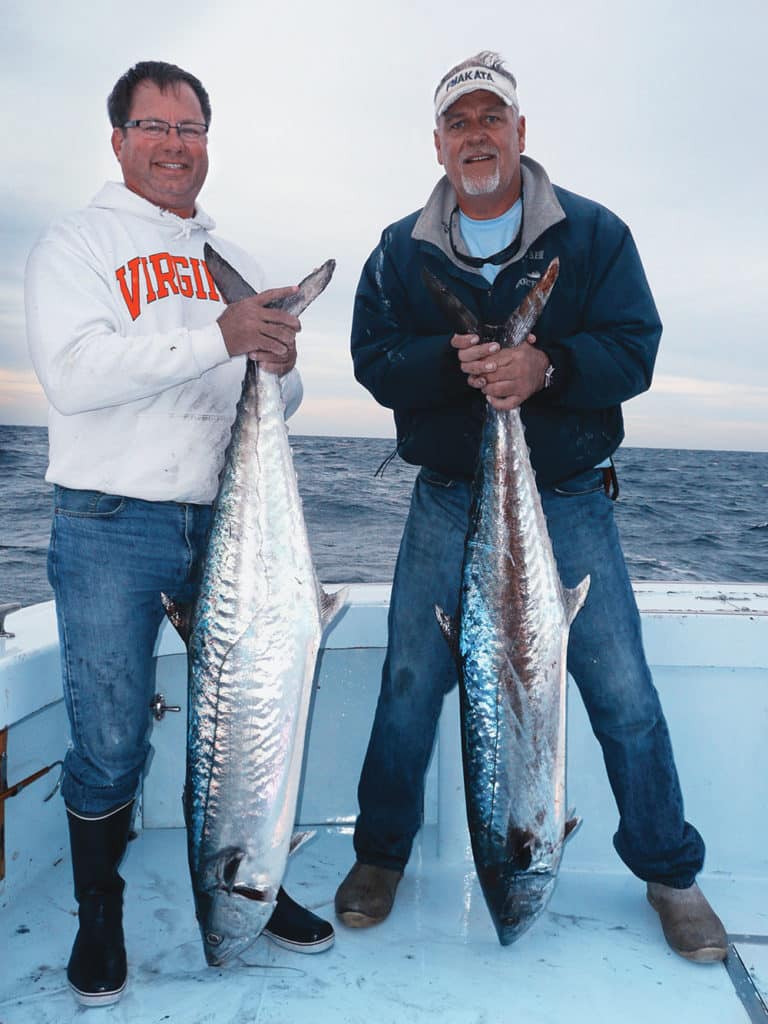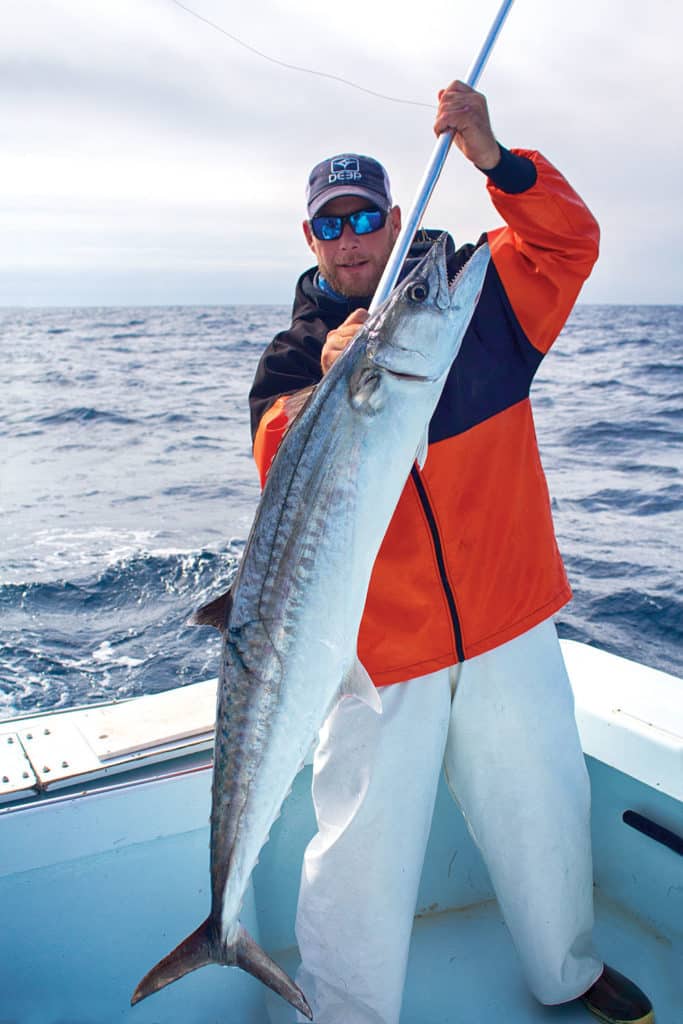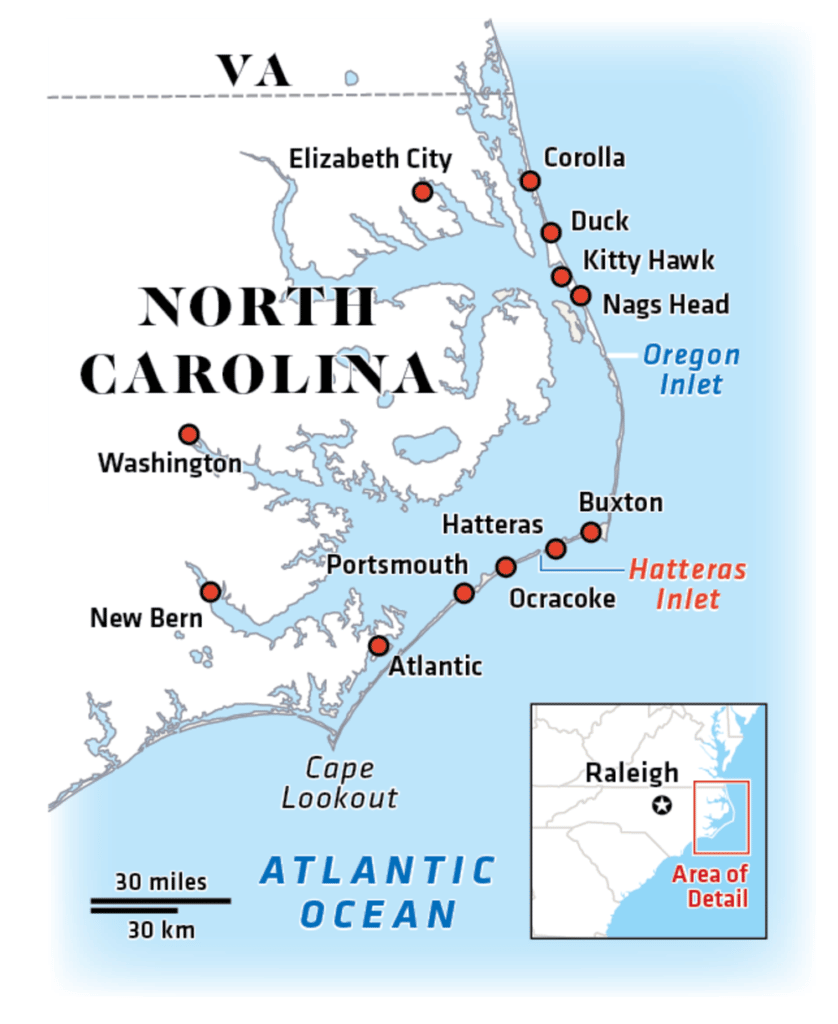
KINGS IN SPADES
An hour after losing sight of Hatteras Inlet in North Carolina, we were slow-trolling in 90 feet of water, about 15 miles from port, in an area where Rooks regularly puts charter customers on kings larger than 30 pounds (aka smokers). Soon, I and the rest of the anglers on board — Jamison and two other friends of the captain, Stuart Wade and John Elmore — got to experience first hand just how good the bite in the Outer Banks can be.

IRRESISTIBLE FATBACKS
Our choice of baits, live menhaden — know locally as “fatbacks” — proved ¬impossible for the fish to resist, and we all got in on the action that first morning. As is typical with kingfish, the strikes came in flurries. A few doubleheaders and several fish hooked in succession turned the fishing into a game of musical chairs requiring quick reactions and fancy footwork to prevent tangles and to keep fish from coming unbuttoned.
By noon, we’d put six or seven kings in the upper 20s in the fish box, along with several cookie-cutter 15-pounders. Nevertheless, the 30-pound-plus smokers I’d come to the Outer Banks for had eluded us. We hooked one fish that would probably have reached that mark, and I had the dubious distinction of being the one who lost it. After a pair of -prolonged sprints that emptied more than half the reel spool, I still couldn’t turn the fish. Then the hook pulled some 15 minutes into the battle.

SMOKERS LIKE IT COOL
Not content with the results, Rooks asked us to crank the lines in and made a move. “We usually find the big boys in the cooler water,” he explained. “Here it’s 75 degrees. Let’s see if we can find an area where the water is a couple of degrees cooler.” After a 20-minute run, our captain slowed the boat down and called for lines in. Although we’d traveled several miles back toward the coast, the water looked just as blue as it did at our first stop. There was, however, one major difference: “The water is 70 degrees,” Rooks announced from the bridge. “We’ll get some big ones here.”

FLEXIBLE SPREAD
The conviction in the captain’s tone wasn’t lost on the crew. Everyone on deck grabbed a rod and dropped a live bait behind the boat. In a couple of minutes, we were again pulling the full spread: two baits on flat lines 50 to 60 feet off the transom corners; two short baits off the outriggers; and a long bait set 75 to 100 yards back off the center rigger.
The number of lines and their positions seemed pretty standard, but Rooks kept changing the lengths, winding up and dropping back the baits 20 feet or so, every few minutes. Had we been using rigged dead ballyhoo or mullet, the placement of the ¬outrigger baits would also have been ¬common. But considering that we were fishing live menhaden, it was surprising. Rooks likes those two baits barely 20 feet behind the tips of the outriggers, so they are periodically yanked out of the water as the boat rocks from side to side. That way, he said, they create a lot of splash, which gets the attention of the fish.

SLASH ATTACK
It wasn’t long before Rooks’ theory was proven right. First, the long bait got whacked. A USO (Unidentified Swimming Object) grabbed a big fatback at full speed and kept on going. Elmore pulled the rod from the holder and took his time fighting what we all suspected was the first true smoker king of the trip.
Only seconds later, a silver torpedo came crashing out of the water off the port side with one of our baits clenched between its teeth. A loud expletive preceded by the word “holy” resonated from the deck of the Tuna Duck. We all yelled it in unison at the sight of the amazing aerial attack. Wade was on the rod the instant that fish came tight, while Koci, Jamison and I tended to the other lines, hoping for additional hookups.
Sure enough, another fish jumped on my bait. With the violent strike, there was no need to set the hook. I just raised the rod, waited for the first run to end, then went to work with the reel. Having learned my lesson, I maintained a lighter 8 pounds of drag this time, so the small treble hook stayed put.
With three kings on at the same time, pandemonium reigned in the cockpit. But one by one, each fish came boat-side, was gaffed and put in the icebox. The smallest was about 20 pounds; the others were both 30-plus. And the action only got hotter as the afternoon wore on. More skyrocketing fish, more hookups and several more large kings came to gaff. To add to the excitement, we also hooked a couple of sailfish.

WELCOME ABOARD
Gaffing a big kingfish in rough seas is not an easy task, and neither is bringing it on board safely. Sinking the gaff hook just behind the head of the fish is ideal. It allows you to subdue and maintain control of it as you pull it over the gunwale. Then take the kingfish straight to the fish box to minimize the potential for injury (don’t forget that mouth full of sharp teeth) or losing the fish after it shakes free of the gaff.

KINGFISH CENTRAL
From snakes to smokers, kingfish of all sizes are plentiful off North Carolina‘s coast in the fall and winter months. And boats out of Cape Hatteras and Port Oregon in the Outer Banks have easy access to some of the very best action, which often takes place just minutes away from the inlets.
SWS PLANNER
North Carolina Smoker Kingfish
What: Trophy king mackerel (aka smokers kings)
Where: Outer Banks, North Carolina
When: Fall and winter, best November through February
Who: Anglers adept at procuring live bait, aboard the right boats designed to withstand the rigors of offshore fishing and rough seas. The following charter operations have the know-how and the right gear to get you hooked up:
Hatteras Inlet Tuna Duck Capt. Dan Rooks 252-216-6160 tunaduck.com
Oregon Inlet Fight-N-Lady Capt. Sam Stokes 800-272-5199 fight-n-lady.com

BE READY TO MULTITASK
A kingfish bite can go from slow to red hot in a matter of seconds. In fact, it’s not uncommon to have 3 or 4 strikes at once. So it’s a huge plus to have a crew that can multitask and re-rig leaders, re-bait hooks, reposition lines, gaff fish, etc. as necessary to take full advantage of every opportunity to hook and land a king. Kenny Koci, the mate aboard Tuna Duck, had all the necessary skills and readily jumped from one task to another without missing a beat.
SWS TACKLE BOX
North Carolina Smoker Kingfish
Rods: 7-foot jigging or conventional, 20- to 50-pound class
Reels: Daiwa Saltist 2-speed lever-drag, sizes 30 and 50, or equivalent high-speed conventional reels
Line: 25-pound mono or 30-pound braid with 30 feet of 40-pound fluorocarbon top shot; 3 feet of 60-pound dark stainless-steel cable leader
Hooks: 4X-strong bronze treble hooks, sizes 4 and 6, rigged in tandem; the smaller treble set 6 to 8 inches behind the larger treble
Bait: Live menhaden (aka fatbacks) are best; live butterfish, small bluefish, or dead menhaden in a pinch

THE 50-POUND CLUB
The next day, Donny Cook joined Koci and me as the only anglers. Rooks, as most experienced captains would do, first tried the spot where we’d found the bigger kings on day one. The fish were still there, and they were hungry. It was all hands on deck most of the day, as we fought one hefty kingfish after another with very little time in between.
We ran out of live menhaden shortly after lunch, so we used butterfish and even a few small bluefish we had in the well. That bought us another hour. Next, we resorted to skipping dead menhaden in our wake. The rigging was almost the same — a 3-foot length of wire leader and a pair of small bronze treble hooks rigged in tandem — but instead of impaling the bait through the nose, one of the points of the lead treble goes in under the chin and out the upper lip. That locks both jaws together, the mouth stays shut and the bait doesn’t spin during trolling.
The dead baits got rave reviews from the smoker kings. Several of them launched themselves out of the water after the skipping fatbacks, while others blasted them on the surface, a scant few yards off the transom. The kicker was a monster fish caught by Cook that later weighed a whopping 52 pounds back at Hatteras Harbor Marina.
As the fog closed in on our way back to port, I couldn’t help but think that, even when many restaurants and businesses are closed for the winter, the allure of this great kingfish fishery is enough for me to return to Hatteras in the off-season. Who knows, maybe next time I’ll join the 50-pound club.









